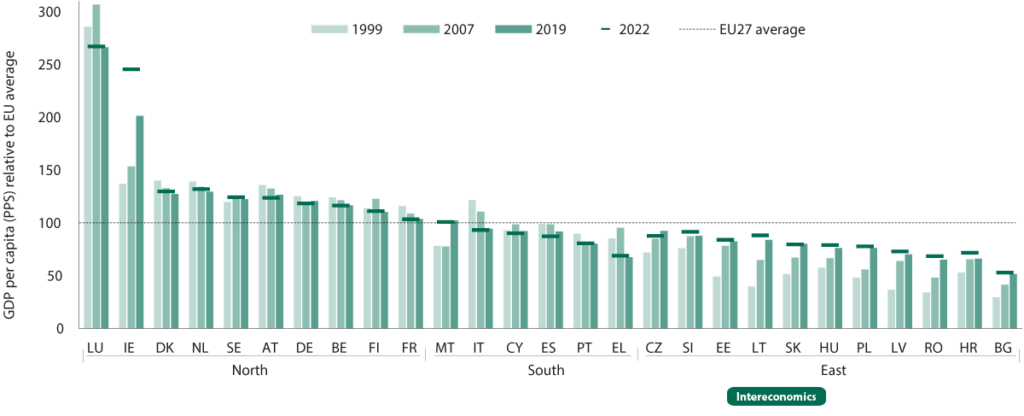The European Union and the Convergence Concept
The European Union (EU), a political and economic union of 27 member states, has long stood as a paragon of cooperation and integration. At the heart of the EU’s ethos lies the concept of convergence, a principle dedicated to diminishing disparities among member states and regions in terms of income, wealth, and living standards. This principle has gained heightened relevance in the wake of the COVID-19 pandemic, which has not only magnified existing inequalities but also introduced new challenges to the EU’s efforts towards convergence.
The Impact of COVID-19 on EU Convergence
The COVID-19 pandemic has exerted a profound impact on the EU, disrupting economies, straining healthcare systems, and exacerbating social inequalities. The pandemic has further illuminated the geographical disparities within the EU, with different regions experiencing varying degrees of impact. For instance, certain regions have been particularly hard-hit by the virus owing to their dependence on sectors such as tourism, which has suffered considerably due to travel restrictions and lockdown measures.
Despite these formidable challenges, the EU has demonstrated resilience and adaptability in its response to the crisis. The EU’s Recovery and Resilience Facility (RRF), in particular, has been instrumental in mitigating the pandemic’s impact and expediting convergence efforts. The RRF allocates financial support to member states for the implementation of reforms and investments that align with the EU’s green and digital transitions, thereby underpinning economic recovery and advancing convergence.
The Role of Policy in EU Convergence
Policy occupies a pivotal position in driving convergence within the EU. Policies designed to spur economic growth, enhance social inclusion, and increase institutional effectiveness are instrumental in mitigating disparities between regions and fostering convergence. For example, policies that encourage investment in education and training can bolster human capital, elevate productivity, and stimulate economic growth, thereby aiding in the process of convergence.
Yet, achieving convergence extends beyond merely adopting appropriate policies; it also necessitates effective governance. Government effectiveness, as gauged by the World Bank’s Worldwide Governance Indicators (WGI), stands as a crucial factor in the convergence equation. Governments that are efficient, transparent, and accountable are more capable of enacting policies that facilitate convergence and responding adeptly to crises, including the COVID-19 pandemic.
The Geographical Dimension of EU Convergence
The geographical aspect of convergence holds particular significance within the EU, reflective of the diversity among its member states and regions. The EU encompasses areas of varied developmental stages, from highly advanced regions in Western Europe to those less developed in Eastern and Southern Europe. Such disparities present considerable obstacles to convergence efforts, as regions at a lower stage of development frequently encounter structural barriers impeding their progress.
Nonetheless, this geographical facet of convergence also unveils opportunities. By discerning the unique challenges and prospects of different regions, the EU can customise its policy measures and interventions to meet the specific needs of each area, thereby fostering inclusive and sustainable growth.
The Future of EU Convergence
Looking ahead, the EU confronts considerable challenges in its pursuit of convergence. The persistent impact of the COVID-19 pandemic, alongside enduring challenges such as climate change and digital transformation, necessitates concerted efforts from all stakeholders.
Nonetheless, the EU possesses formidable strengths that can be harnessed in its convergence endeavours. The EU’s robust institutional framework, its dedication to solidarity and cooperation, and its capacity to mobilize resources on a continental scale represent significant assets that can be leveraged to advance convergence.
In conclusion, the imperative for the EU’s convergence efforts has intensified in the aftermath of the COVID-19 pandemic. By championing convergence, the EU can forge a more resilient, inclusive, and sustainable future for all its citizens.
Conclusion: The Path Forward for EU Convergence
The COVID-19 pandemic has starkly highlighted the significance of convergence within the EU. As we advance, it becomes crucial to apply the lessons gleaned from this crisis to bolster our efforts towards convergence. This endeavour necessitates a multi-dimensional strategy, encompassing effective policymaking, robust governance, and a sophisticated grasp of the geographical nuances of convergence.
The journey towards convergence is fraught with obstacles; yet, these very challenges also unveil prospects for growth and renewal. By seizing these opportunities, we can cultivate an EU that is not only more equitable and resilient but also adept at navigating future adversities.
Ultimately, convergence transcends the mere bridging of disparities; it envisages the creation of a union that transcends the sum of its parts—a future in which all regions and citizens of the EU can flourish. As we traverse the post-pandemic landscape, let us pledge to this vision of a united and robust EU.

